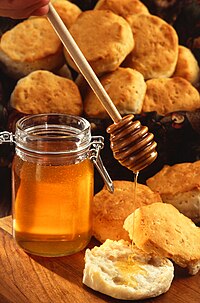
Photo from wikipedia
Honeybee products, as multicomponent substances, have been a focus of great interest. The present work aimed to perform the nutritional and chemical profiling and biochemical characterization of bee pollen (BP),… Click to show full abstract
Honeybee products, as multicomponent substances, have been a focus of great interest. The present work aimed to perform the nutritional and chemical profiling and biochemical characterization of bee pollen (BP), bee bread (BB), and royal jelly (RJ) and study their applications in the fortification of functional fermented dairy products. Their effects on starter cultures and the physicochemical and sensorial quality of products were monitored. A molecular networking analysis identified a total of 46 compounds in the three bee products that could be potential medicines, including flavonoids, fatty acids, and peptides. BB showed the highest protein and sugar contents (22.57 and 26.78 g/100 g), which cover 45.14 and 53.56% of their daily values (DVs), with considerable amounts of the essential amino acids threonine and lysine (59.50 and 42.03%). BP, BB, and RJ can be considered sources of iron, as 100 g can cover 141, 198.5, and 94.94% of DV%, respectively. BP was revealed to have the highest phenolic and flavonoid contents (105.68 and 43.91 µg/g) and showed a synergetic effect when mixed with RJ, resulting in increased antioxidant activity, while BB showed a synergetic effect when mixed with RJ in terms of both antioxidant and proteolytic powers (IC50 7.54, 11.55, 12.15, 12.50, and 12.65 cP compared to the control (10.55 cP)), reflecting their organoleptic properties and highlighting these health-oriented products as promising natural products for human health care.
Journal Title: Molecules
Year Published: 2022
Link to full text (if available)
Share on Social Media: Sign Up to like & get
recommendations!